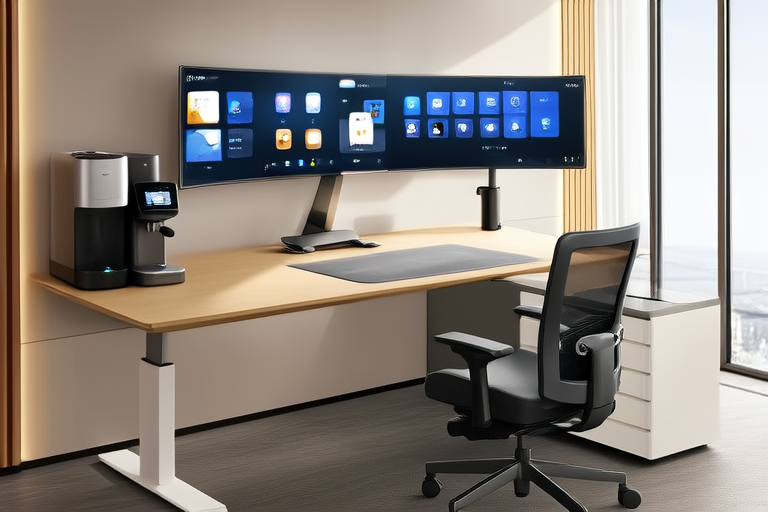Integrating Smart Devices into Your Office Setup: Tips for Creating a Tech-Savvy Workplace Environment
Introduction
In today’s fast-paced world, integrating smart devices into your office setup is no longer just a luxury; it has become a necessity for maintaining productivity and efficiency. A tech-savvy workplace environment not only streamlines tasks but also enhances collaboration and communication among team members. Whether you’re a small business owner or part of a large corporate setup, optimizing your office with smart devices can significantly improve workflow and employee satisfaction. This article will guide you through the process of integrating these devices, offering practical tips and actionable advice to create an efficient and modern workspace.
Understanding Smart Devices in the Office
What Are Smart Devices?
Smart devices are internet-connected gadgets that can be controlled remotely via smartphones, tablets, or computers. These devices range from simple sensors to complex systems like smart thermostats, lighting controls, and even advanced AI-driven assistants. In an office setting, smart devices can automate routine tasks, monitor energy usage, and provide real-time data on performance metrics. By leveraging these tools, businesses can reduce operational costs while increasing overall productivity.
Benefits of Using Smart Devices
- Enhanced Efficiency: Automation reduces manual labor, allowing employees to focus on more critical tasks.
- Cost Savings: Energy-efficient smart thermostats and lighting systems lower utility bills.
- Improved Security: Smart surveillance cameras and access control systems enhance safety measures.
- Better Communication: Tools like video conferencing software facilitate seamless communication across different locations.
Selecting the Right Smart Devices for Your Office
Assessing Your Needs
Before diving into the market, take some time to assess your specific needs. Consider factors such as the size of your office, the number of employees, and the types of tasks performed daily. For instance, if you have multiple meeting rooms, investing in high-quality video conferencing equipment would be beneficial. On the other hand, if energy conservation is a priority, smart thermostats and motion-sensor lights might be more suitable.
Research and Compare
Once you’ve identified your requirements, conduct thorough research to find the best options available. Look for user reviews, compare features, and check compatibility with existing systems. It’s also essential to consider the vendor’s reputation for customer support and product reliability. Some popular brands in this space include Philips Hue for smart lighting, Nest for thermostats, and Logitech for video conferencing solutions.
Setting Up Your Smart Office Environment
Installation Process
Installing smart devices requires careful planning and execution. Start by ensuring all necessary hardware components are present, including hubs, sensors, and controllers. Follow the manufacturer’s instructions closely during installation to avoid any issues. Many smart home hubs come with mobile apps that allow easy setup and configuration of connected devices. Additionally, ensure that your network infrastructure supports the new additions—this may involve upgrading routers or installing additional Wi-Fi extenders.
Customizing Settings
After installation, customize settings according to your preferences. For example, adjust temperature thresholds for smart thermostats based on seasonal changes or schedule lights to turn off automatically after hours. You can also set up voice commands using virtual assistants like Amazon Alexa or Google Assistant for hands-free operation. Personalizing these settings ensures optimal functionality tailored specifically to your workspace needs.
Maximizing Productivity with Smart Devices
Leveraging Data Analytics
One significant advantage of incorporating smart devices into your office setup is the ability to collect valuable data. Many modern smart devices come equipped with analytics capabilities that track usage patterns and provide insights into areas where improvements can be made. Use this information to optimize workflows further, identify bottlenecks, and implement targeted strategies aimed at boosting productivity.
Encouraging Collaboration
Smart devices can foster better collaboration among team members by breaking down physical barriers. Video conferencing tools enable face-to-face interactions regardless of geographical distances, while shared digital whiteboards encourage brainstorming sessions and idea exchange. Implementing these technologies promotes a collaborative culture within your organization, leading to more innovative solutions and higher job satisfaction levels.
Case Study: A Successful Smart Office Implementation
Company Overview
XYZ Corp operates a mid-sized office space housing approximately 50 employees spread across three departments—sales, marketing, and IT.
Challenges Faced
The company struggled with inconsistent lighting conditions affecting employee comfort and productivity. Additionally, managing HVAC systems manually was time-consuming and inefficient.
Solution Implemented
XYZ Corp installed Philips Hue smart bulbs throughout the premises, allowing staff members to adjust brightness levels according to personal preferences. They also invested in Nest Learning Thermostats which automatically regulated temperatures based on occupancy sensors. Furthermore, they introduced Zoom Pro accounts for enhanced video conferencing experiences during remote meetings.
Results Achieved
Within six months of implementation, XYZ Corp reported a 15% increase in overall employee satisfaction scores. Energy consumption decreased by 20%, resulting in substantial savings on utility bills. Moreover, improved communication channels led to faster decision-making processes and increased sales figures.
Conclusion
Creating a tech-savvy workplace environment involves thoughtful consideration of various aspects, from initial assessment to final customization. By carefully selecting appropriate smart devices and following proper installation procedures, organizations can enjoy numerous benefits such as enhanced efficiency, cost savings, and improved security. Remember to leverage data analytics to continuously refine operations and encourage collaboration among teams. Ultimately, adopting these practices will help build a smarter, more productive office space conducive to long-term success.
